The NVIDIA GeForce GTX 1080 Ti Founder's Edition Review: Bigger Pascal for Better Performance
by Ryan Smith on March 9, 2017 9:00 AM ESTGrand Theft Auto V
The latest edition of Rockstar’s venerable series of open world action games, Grand Theft Auto V was originally released to the last-gen consoles back in 2013. However thanks to a rather significant facelift for the current-gen consoles and PCs, along with the ability to greatly turn up rendering distances and add other features like MSAA and more realistic shadows, the end result is a game that is still among the most stressful of our benchmarks when all of its features are turned up. Furthermore, in a move rather uncharacteristic of most open world action games, Grand Theft Auto also includes a very comprehensive benchmark mode, giving us a great chance to look into the performance of an open world action game.
On a quick note about settings, as Grand Theft Auto V doesn't have pre-defined settings tiers, I want to quickly note what settings we're using. For "Very High" quality we have all of the primary graphics settings turned up to their highest setting, with the exception of grass, which is at its own very high setting. Meanwhile 4x MSAA is enabled for direct views and reflections. This setting also involves turning on some of the advanced redering features - the game's long shadows, high resolution shadows, and high definition flight streaming - but it not increasing the view distance any further.
Otherwise for "High" quality we take the same basic settings but turn off all MSAA, which significantly reduces the GPU rendering and VRAM requirements.
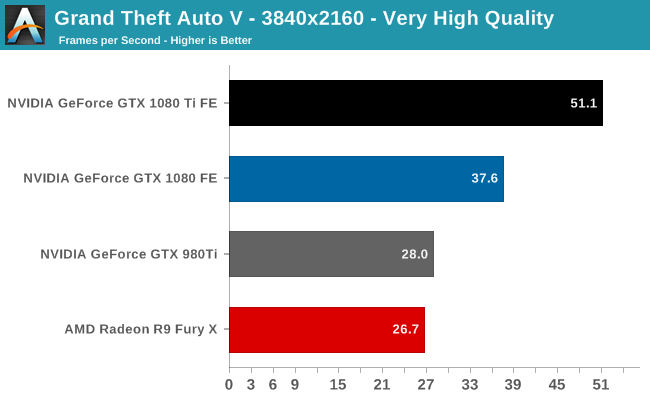
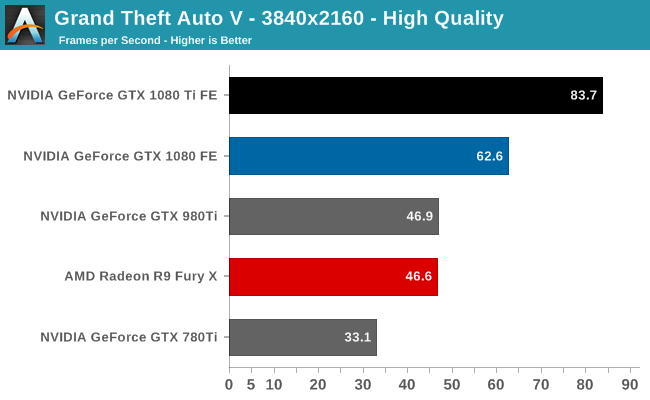
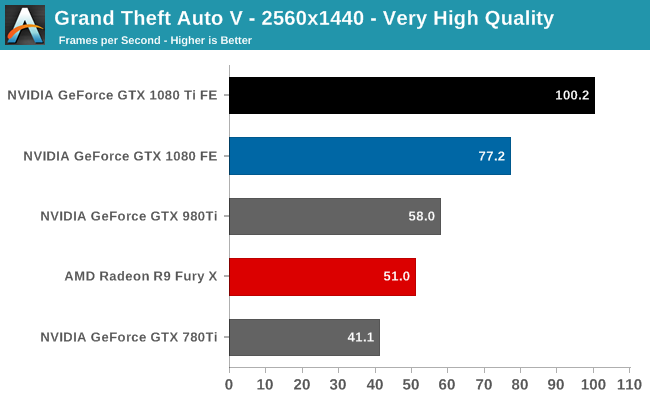
Grand Theft Auto V is another game where the GTX 1080 Ti won’t quite reach 60fps at 4K with all the bells & whistles, but it gets close in doing so. Given that this was originally a console game that ran at 30fps, 51.1 should make a lot of people reasonably satisfied, but there’s always room for improvement.
Relative to the GTX 980 Ti, this is actually the GTX 1080 Ti’s best game; it picks up a better-than-average 83% in performance. I suspect that GTAV is an outlier that is especially memory bandwidth sensitive, benefitting from the combination of a raw 44% increase in memory bandwidth from the previous generation, and NVIDIA’s improved memory compression technology on the Pascal architecture.
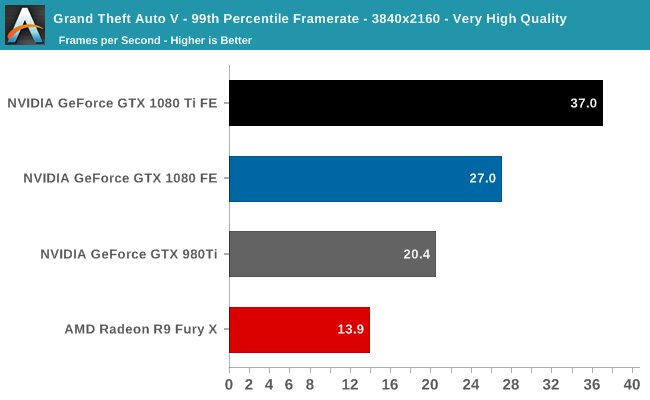
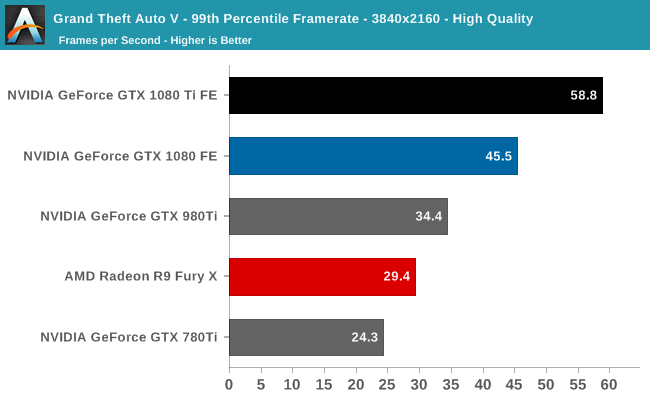

Looking at the minimum framerates, the story is much the same. For gamers looking for high minimum framerates, the GTX 1080 Ti is the first card that can deliver better than 30fps at the 99th percentile. So while it can’t average 60fps, it also will never drop to the 30fps rate that its console counterparts are capped at in the first place.










161 Comments
View All Comments
SaolDan - Thursday, March 9, 2017 - link
i dont need it but i really want it. currently gaming and vr on a 1070 and loving it.Endda - Thursday, March 9, 2017 - link
Would have loved to see the Titan XP in those graphsRyan Smith - Thursday, March 9, 2017 - link
Unfortunately NVIDIA never sampled us on that one, so I don't have one on-hand to test again.Samus - Thursday, March 9, 2017 - link
Can't wait to pickup one of these in a year for ~$400. Easily future-proof for the next generation of console games, and my 780Ti is really showing its age, by about 154%...Nfarce - Friday, March 10, 2017 - link
If you think you are going to see a 1080Ti in 12 months selling for $400, I've got a like-new Ferrari to selling you for $15k. It will be nearly summer before the AIB GPUs (ASUS, EVGA, Gigabyte, MSI, etc.) start becoming available in decent supply.rtho782 - Thursday, March 9, 2017 - link
I know I'm an outlier, but having lived with SLI 980s for a couple of years I'm looking to go back to a single card, and I really wish I could find SLI 980 to 1080ti benchmarks :PDrumsticks - Thursday, March 9, 2017 - link
I think the original AT review of the 1080 compares them. Go there and just tack on another 30% maybe?mapesdhs - Saturday, March 11, 2017 - link
If it's of any help, I've done a fair few 980 SLI tests for 3DMark, Unigine, etc., you could compare those to 1080 Ti reviews (several sites have included 3DMark results, and Techpowerup has a couple of Unigine results threads/tables); PM me for links, or email (Google "Ian SGI", find the Contact page, use my Yahoo address).Achaios - Thursday, March 9, 2017 - link
It should be borne in mind that Benchmark results are misleading, especially when referring to the 780TI.The 780TI launched at ridiculously low clocks of 875MHz Core Clock and 928 MHz Boost Clock, which wasn't much different from what a GTX 580 OC'd could do.
When overclocked, the 780TI worked at around 1.25 GHz, a huge difference over the stock card.
So, while the 1080TI has got more than double the performance of an OC'd 780TI as per 3D Mark Firestrike, the performance shown herein for the 780TI is ridiculously low and thus, misleading.
Yojimbo - Thursday, March 9, 2017 - link
I guess if you're worried about someone making judgments of general GPU trends without fully researching it, that's true. But owners of 780 Ti cards should be aware of where their individual cards sit compared to the reference design. In any case it's always going to be hairy taking overclocking performance into account when making judgments about generational trends. For instance, 2017 1060s and 1080s are going to be able to overclock better than 2016 1060s and 1080s. There's also a whole range of clock speeds that come out. Do you take the fastest or the average? If you take the average do you take the average of the SKUs or an average weighted by units sold? It's not so easy to get an accurate picture without a lot of work.